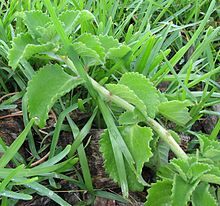- Plectranthus amboinicus
-
Plectranthus amboinicus 
Scientific classification Kingdom: Plantae (unranked): Angiosperms (unranked): Eudicots (unranked): Asterids Order: Lamiales Family: Lamiaceae Genus: Plectranthus Species: P. amboinicus Binomial name Plectranthus amboinicus
(Lour.) Spreng.Synonyms Coleus amboinicus Lour.
Coleus aromaticus Benth.Plectranthus amboinicus is a tender fleshy perennial plant in the family Lamiaceae with an oregano-like flavor and odor, native to Southern and Eastern Africa, but widely cultivated and naturalised in the Old and New World Tropics. Common names include Cuban oregano, Spanish thyme, Orégano Brujo (Puerto Rico), Indian Borage, Húng chanh (Vietnam), Big Thyme (Grenada) Mexican thyme, Mexican mint, Queen of herbs, three-in-one herb, allherb and Mother of herbs.
Contents
Description
The Indian Borage is very commonly grown as a potted plant. The Indian Borage is a fast growing plant. Propagation is via stem cuttings. To encourage a bushy plant, cut the tip of the top, insert into the soil and instantly, you have another plant as the cutting will grow within days.The Indian Borage ideally should be grown in a semi-shaded and moist location as the leaves will remain a beautiful jade-green colour. If it is getting too much sun, the leaves turn yellow, start curling and look unsightly; if not enough sun, the leaves turn a dark shade of green and spaced out.
Cultivation
The herb grows easily in a well-drained, semi-shaded position. It is frost tender (Hardiness USDA Zones 10-11) [1] and grows well in sub-tropical and tropical locations, but will do well in cooler climates if grown in a pot and brought indoors, or moved to a warm sheltered position in winter. Water only sparingly.
Uses
The leaves are strongly flavoured and make an excellent addition to stuffings for meat and poultry. Finely chopped, they can also be used to flavour meat dishes, especially beef, lamb and game.
The leaves have also had many traditional medicinal uses, especially for the treatment of coughs, sore throats and nasal congestion, but also for a range of other problems such as infections, rheumatism and flatulence. In Indonesia Plectranthus amboinicus is a traditional food used in soup to stimulate lactation for the month or so following childbirth.
The herb is also used as a substitute for oregano in the food trade and food labelled "oregano-flavoured" may well contain this herb.
In the Indian state of Tamilnadu it is called as கற்பூரவள்ளி (Karpooravalli) and in Kerala it is called as പനിക്കൂർക്ക (panikoorka) and has various uses in treating cold / cough / fever. See reference section.
References
Sources
[1] Coleus aromaticus [2] [3] [4] [5]
Categories:- Plectranthus
- Plants described in 1825
- Flora of East Africa
- Flora of Southern Africa
- Vietnamese ingredients
- Puerto Rican ingredients
- Lamiaceae stubs
Wikimedia Foundation. 2010.


